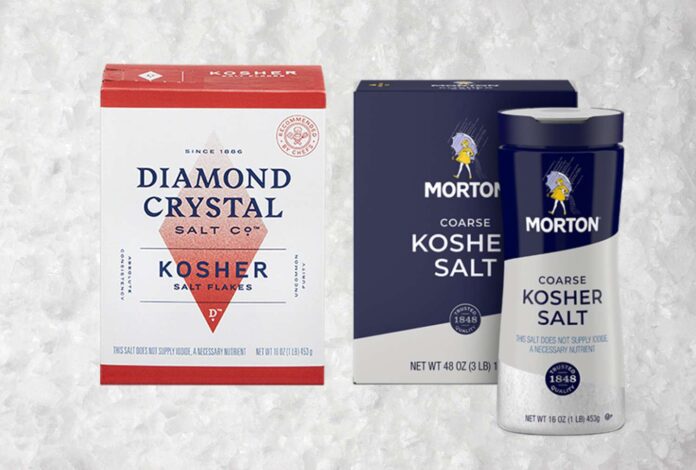:max_bytes(150000):strip_icc():format(jpeg)/What-is-the-difference-between-Mortons-and-Diamond-Crystal-salt-FT-BLOG1124-717e15b8a8c148559dcc953c566d1bd1.jpg)
The right type (and amount) of salt can make or break a dish. Morton and Diamond Crystal are the most common brands of kosher salt you’ll find on shelves. Despite the name, they aren’t interchangeable, and choosing which to use can be a point of confusion for home cooks.
While there are exceptions, chefs and cookbook authors tend to prefer Diamond Crystal kosher salt for its lower sodium content, less coarse texture, and ability to dissolve quickly, which all allow for more precise seasoning. In fact, our test kitchen exclusively tests recipes with Diamond Crystal. But Morton has its uses too, and you can substitute one for the other in a pinch by making some smart adjustments. Here’s everything you need to know before salting your next recipe.
What is kosher salt?
In cooking, when we taste “salt,” we are tasting sodium chloride, which comes from mines or from evaporated brine or sea water. The difference between salts is most often just textural – think of the tiny slippy grains of table salt, the rough granules of kosher salt, and the flaky crunchy crystals of sea salt.
Kosher salt is a pure, coarse-grained, additive-free salt that doesn’t include any anti-caking agents or iodine; it is less salty than fine-grained table salt and the preferred option of most chefs for cooking. That’s because the grains are small enough to dissolve quickly into recipes but big enough to feel when handling.
Morton vs. Diamond Crystal
Morton has been headquartered in Chicago since 1848, and in 1914 introduced the iconic umbrellaed Morton Salt Girl to emphasize the free-flowing quality of its table salt, which has a small amount of magnesium carbonate added to prevent clumping. Morton kosher salt is relatively coarse, and is made by rolling cubes into flakes that have a distinctly square-ish shape.
Produced since 1886 in St. Clair, Michigan, Diamond Crystal Kosher Salt is made by evaporating brine in open pans. According to its website, Diamond salt has no additives and contains 53% less sodium by volume than table salt thanks to the unique shape of the granules — the open-pan method creates hollow, pyramid-shaped crystals.
Beyond their textural differences, the biggest difference between Morton and Diamond Crystal is their sodium content. A ¼-teaspoon measurement of Morton contains 480 milligrams of sodium, whereas ¼ teaspoon of Diamond Crystal is equal to 280 milligrams of sodium — a significant difference. In fact, a recipe will be about 58% saltier if you use Morton over Diamond.
Which salt is better for cooking?
Chefs tend to prefer Diamond Crystal over Morton for several reasons. “First and foremost it’s a tactile thing,” says Rodney Stato, executive chef and culinary director of Chicago-based Meadowlark Hospitality. Because the grains of Diamond salt are hollow and 3-D, “its surface area is smaller by weight so it covers [foods] more consistently and evenly,” he says. Morton’s larger granules provide “less precision when seasoning on the line.”
Its lower sodium content by volume means Diamond has a more delicate taste, and the hollow granules allow it to dissolve rapidly. That means more immediate seasoning so you’re less likely to accidentally oversalt your dish. Diamond is also less slippery than Morton, a subtlety that chefs notice pinch after pinch. What’s more, Diamond tends to adhere better to food, again because of the pyramid-shaped grain.
Rodney Stato, executive chef and culinary director of Meadowlark Hospitality
“Diamond Crystal’s surface area is smaller by weight so it covers [foods] more consistently and evenly.”
— Rodney Stato, executive chef and culinary director of Meadowlark Hospitality
“It’s a salt you can trust,” Staton says. The consistency with the grind makes cooks feel very comfortable.”
Staton is quick to recommend Morton for less precise (and more salty) uses like pickling, brining, and preserving. “It’s a solid product [that has] been around forever.” As for baking, Morton’s coarser grain can be difficult to measure and dissolve in batters and doughs, so it should be reserved for sprinkling atop pretzels or focaccia before baking for that pleasing crunchiness. It also performs perfectly on the rim of a Margarita or Bloody Mary glass, something that Diamond’s finer grains can’t do.
How to substitute one for the other
Because these two kosher salts have a significantly different salt content, you can’t use them in place of each other without making adjustments. One teaspoon of Morton will give you roughly the same saltiness as 1¾ teaspoons of Diamond Crystal. That being said, always be sure to taste your dishes for seasoning and adjust as needed.



